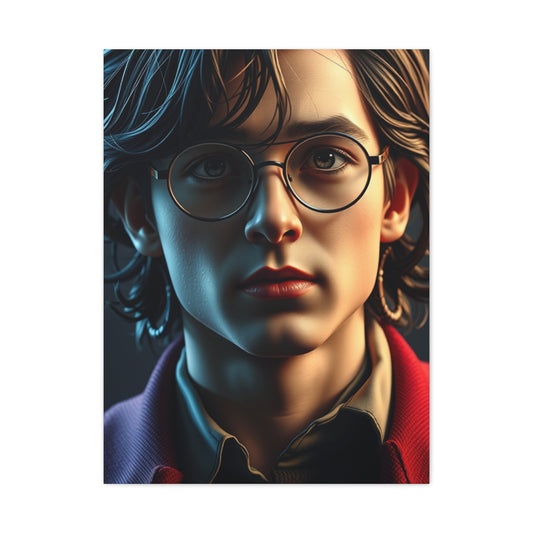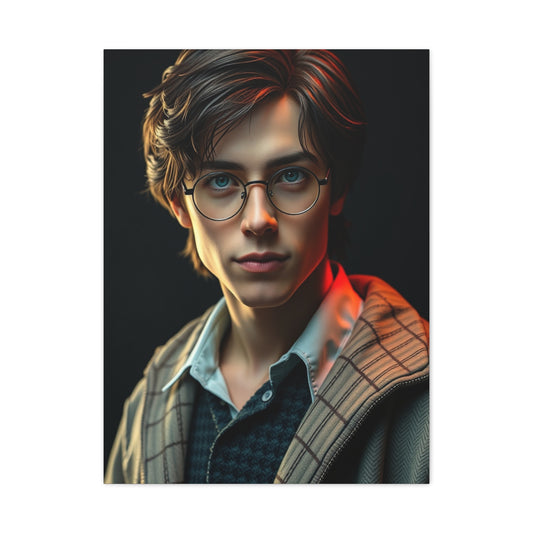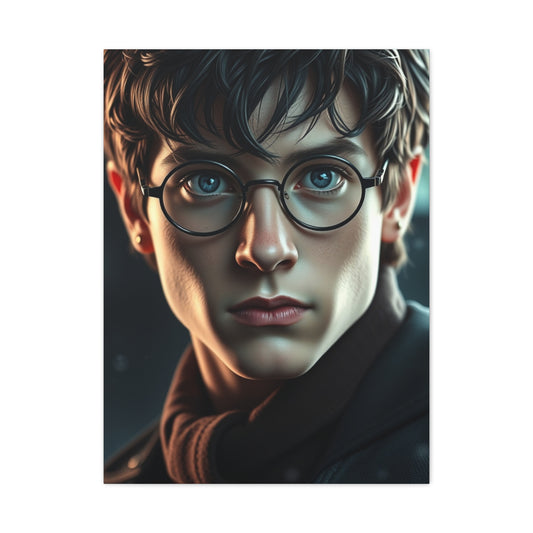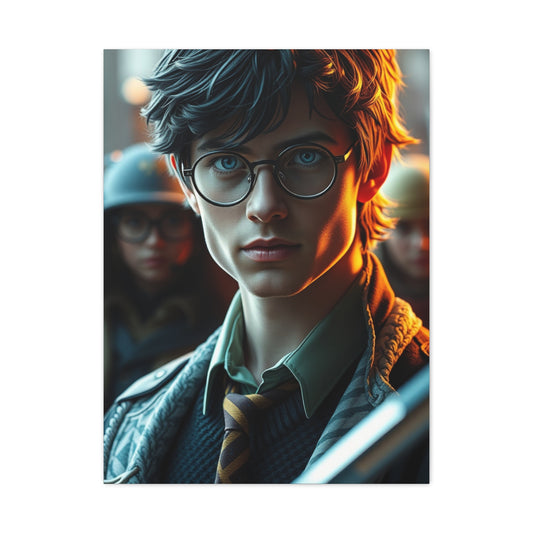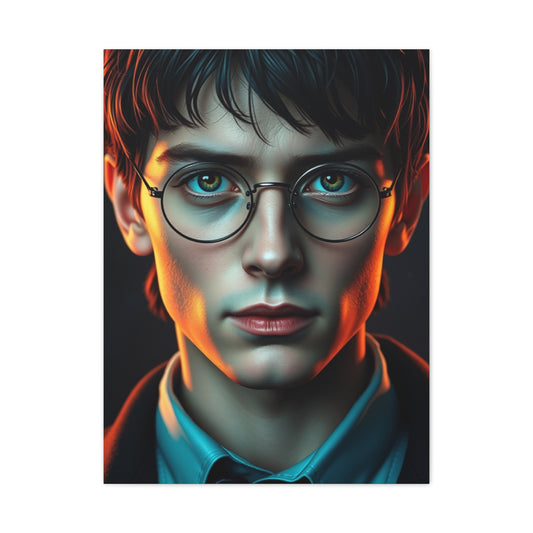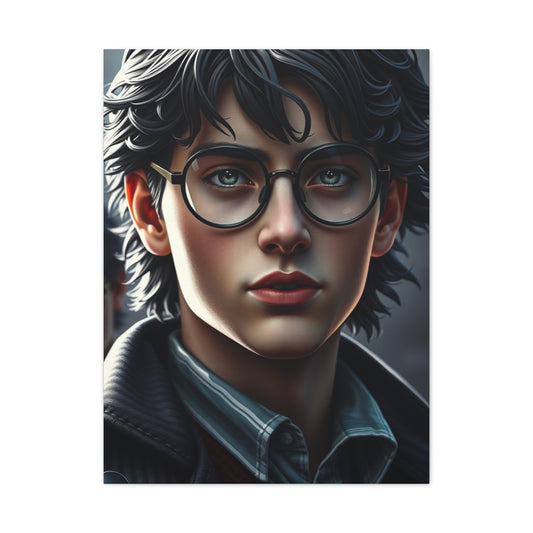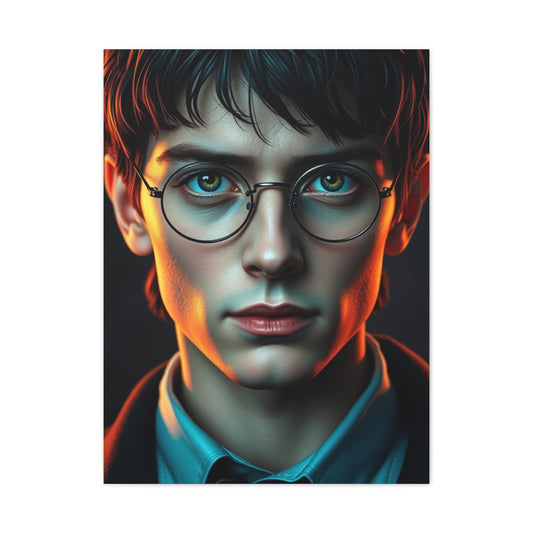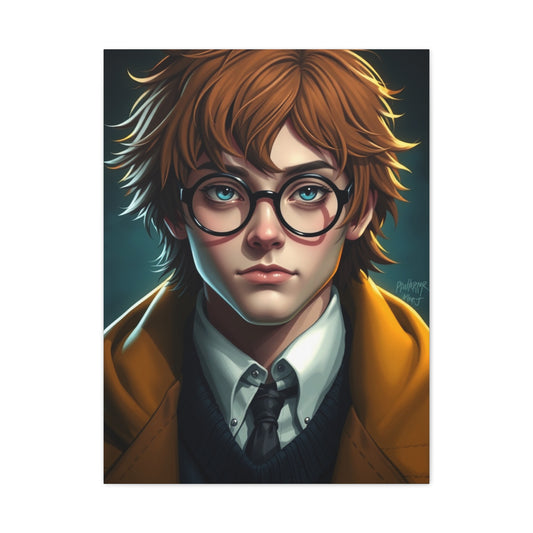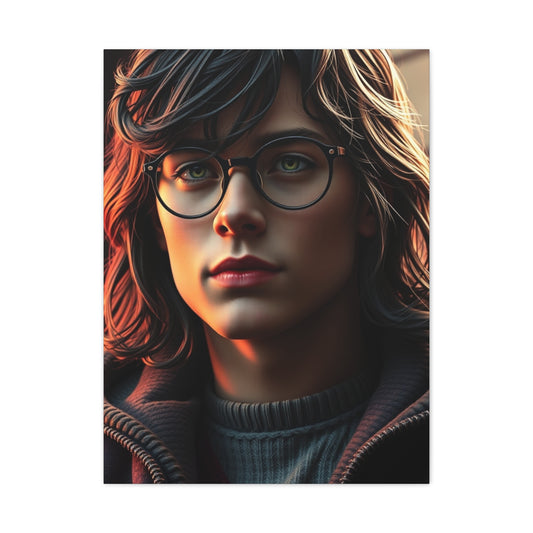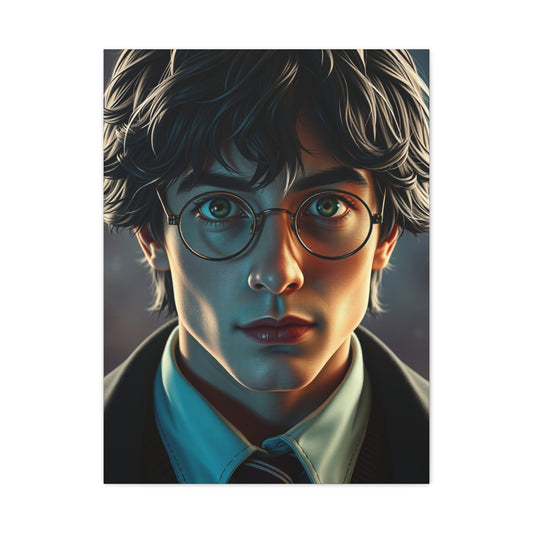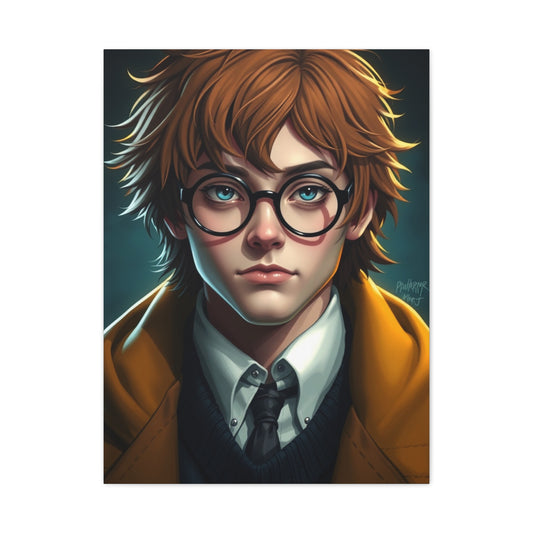Bring Hogwarts to Life through Harry Potter Characters Wall Art
The allure of the wizarding world has captivated generations, and there is no better way to honor that fascination than through wall decor. Transforming your living space into a realm inspired by magic allows a unique form of self-expression. A Harry Potter-inspired print can act as both an aesthetic focal point and a daily reminder of courage, resilience, and imagination. The enchantment of the series is not confined to pages or screens—it can be manifested in every corner of your home, from bedrooms to offices, creating a microcosm of Hogwarts and its legendary ambiance.
Decorating with Harry Potter motifs allows the integration of your personal narrative into your living environment. A space adorned with wizarding elements becomes more than mere decoration; it is a testament to the stories, values, and characters that have shaped your perception of adventure and friendship. Whether it is an illustration of an iconic scene, a representation of a beloved character, or an abstract symbol inspired by magical lore, each piece of wall decor conveys a story. The presence of these elements imbues a room with subtle charm and latent energy, offering both comfort and inspiration.
One of the most compelling aspects of incorporating Harry Potter wall decor is the interplay between thematic fidelity and stylistic versatility. Modern interior design allows the fusion of fantastical elements with contemporary aesthetics. For instance, a monochromatic print depicting a wand or spell motif can harmonize with minimalist decor, creating an understated magical atmosphere. On the other hand, vibrant illustrations of Hogwarts houses or characters provide an exuberant splash of color, transforming any space into a visual narrative that celebrates adventure, intellect, and loyalty. The capacity for these pieces to oscillate between subtlety and exuberance ensures that fans of all ages can find suitable art for their surroundings.
Typography-inspired prints are a particularly engaging method to incorporate the wizarding world into your home. Quoted passages from the series, when rendered with elegant typefaces, invite contemplation and spark conversation. These prints not only pay homage to the characters and their narratives but also introduce a cerebral quality to your environment. They can serve as reminders of pivotal lessons from the series, such as the enduring value of friendship, the courage to confront adversity, and the transformative power of hope. Typography becomes a vessel for both aesthetic and emotional resonance, merging the visual appeal of a print with the philosophical depth of the source material.
Character illustrations offer another dimension to wall decor. The appeal of whimsical or detailed depictions lies in their ability to evoke nostalgia while maintaining a sense of novelty. Selecting a favorite character, whether it be the titular hero, a loyal companion, or even a mischievous magical creature, allows personalization on a profound level. These artworks can vary in style, ranging from realistic portrayals that capture the subtleties of emotion to more abstract renditions that emphasize movement, symbolism, or color. Such prints can serve as anchor points in a room, drawing the eye and generating dialogue, particularly when displayed in communal spaces like living rooms or home libraries.
House-themed artwork provides another layer of personalization. The four Hogwarts houses—each characterized by distinct values and traits—offer rich symbolic potential. A Gryffindor-inspired print might radiate courage and daring through bold color schemes and dynamic compositions. Conversely, a Ravenclaw piece could celebrate intellect and creativity with intricate patterns or abstract representations of wisdom. Slytherin and Hufflepuff artworks similarly convey ambition and loyalty, respectively, each contributing to the thematic diversity of a space. By selecting pieces that reflect personal affinity, you can subtly weave elements of identity, aspiration, and affinity into the fabric of your home environment.
The magical world thrives not only on individual identity but also on the balance of whimsy and drama. Some wall art captures the darker, more mysterious elements of the series, offering brooding silhouettes, enchanted forests, or shadowed castle vistas. These pieces evoke a sense of intrigue and sophistication, suitable for rooms where a more contemplative ambiance is desired. Complementary pieces can lighten the atmosphere, featuring playful depictions of magical creatures, mischievous characters, or humorous scenes from the narrative. The juxtaposition of shadow and levity creates a dynamic environment that mirrors the multifaceted nature of the series itself.
Street-art-inspired designs introduce a contemporary twist to wizarding wall decor. Urban aesthetics, including graffiti motifs and edgy textures, merge the fantastical elements of the Harry Potter universe with modern subcultural expression. Such prints are particularly suited to loft-style apartments, studios, or rooms designed with an industrial flair, where the rawness of street art harmonizes with exposed materials and minimalist furnishings. These designs offer an unexpected juxtaposition, bridging the gap between traditional narrative art and avant-garde urban expression, while retaining recognizable magical symbolism.
Minimalist designs also hold immense appeal. A print featuring subtle wand motifs, spell insignias, or abstract magical symbols can integrate seamlessly into a modern, uncluttered space. Minimalism, when combined with magical motifs, produces an elegant, contemplative ambiance, allowing the artwork to act as a quiet but potent presence. Neutral color palettes, restrained line work, and thoughtful placement ensure that even a single piece can command attention, providing a focal point that enhances the room’s character without overwhelming the visual field.
Ultimately, incorporating Harry Potter wall decor is an exercise in balancing personal expression, thematic cohesion, and stylistic harmony. Whether drawn to bold, narrative-driven illustrations, typography celebrating memorable quotes, minimalist enchantment, or street-art inspired edge, each choice reflects both the magical universe and the inhabitant’s individual tastes. The transformative potential of such decor extends beyond mere aesthetics—it reimagines familiar spaces, evokes cherished memories, and conjures a sense of wonder that persists long after the initial visual impact.
House Pride and Iconic Hogwarts Symbols
The magical realm of Harry Potter offers an abundance of visual and thematic inspiration, particularly through the symbolism embedded within the four Hogwarts houses. Each house embodies distinct traits, providing a wealth of options for wall decor that resonates with personal identity. Selecting artwork inspired by these houses allows fans to curate spaces that reflect individual characteristics, aspirations, and values, while also celebrating the narrative complexity of the wizarding universe.
Gryffindor, characterized by bravery, determination, and chivalry, often inspires bold, energetic art. Pieces featuring the house emblem or dynamic representations of courage, such as a lion mid-roar or a sweeping depiction of heroic moments from the series, can invigorate any room. Using rich reds and golds not only aligns with the traditional house colors but also introduces warmth and intensity to the space. Gryffindor-inspired decor is especially suited for areas meant to inspire action and confidence, such as home offices, study spaces, or creative studios. A well-placed artwork can serve as a visual talisman, reminding inhabitants to confront challenges with valor and perseverance.
Slytherin, synonymous with ambition, resourcefulness, and cunning, offers a contrasting palette and aesthetic approach. Dark greens, silvers, and intricate motifs can create an atmosphere of sophistication and intrigue. Art inspired by Slytherin may include serpentine imagery, ornate patterns reminiscent of magical artifacts, or stylized depictions of characters known for their strategic minds. These pieces are particularly compelling in spaces designed for contemplation, planning, or intellectual pursuits, as they convey a sense of depth, elegance, and purposeful intent. Slytherin-themed prints can also add dramatic flair to living rooms or hallways, creating focal points that intrigue and captivate visitors.
Hufflepuff, with its emphasis on loyalty, patience, and dedication, inspires warmth and inclusivity in wall decor. Yellow and earthy tones, paired with soft textures and gentle imagery, evoke a sense of comfort and community. Illustrations of the house emblem, magical creatures such as badgers, or cozy, enchanted scenes can transform a room into a sanctuary of calm and reassurance. Hufflepuff-inspired art is ideal for communal spaces where a welcoming and nurturing atmosphere is desired, such as kitchens, family rooms, or shared workspaces. By integrating these motifs, a room can feel both harmonious and heartfelt, offering subtle reminders of steadfastness and unity.
Ravenclaw embodies intelligence, creativity, and a love for learning, lending itself to decor that is cerebral and aesthetically intricate. Art featuring stylized eagles, abstract representations of knowledge, or symbolic depictions of magical wisdom introduces an air of refinement and contemplation. Cool blues, silver accents, and geometric compositions can harmonize with modern or eclectic interiors, while also serving as visual prompts for curiosity and exploration. Ravenclaw-inspired prints are particularly effective in libraries, reading nooks, or study areas, where the thematic resonance of knowledge and insight complements functional spaces for reflection and growth.
Beyond individual houses, combining elements from all four provides an opportunity to celebrate the broader diversity of Hogwarts. A single multi-panel artwork or a curated gallery wall can juxtapose each house’s distinct colors, symbols, and themes, creating a dynamic and visually engaging composition. Such arrangements not only honor the narrative richness of the series but also invite viewers to appreciate the interplay between contrasting values, styles, and personalities. A mixed-house display can serve as a subtle conversation starter while demonstrating a comprehensive admiration for the universe of Harry Potter.
In addition to house-specific decor, iconic Hogwarts symbols are an integral component of magical wall art. The castle itself, rendered in sweeping landscapes or abstract silhouettes, evokes grandeur, mystery, and timelessness. Art depicting enchanted corridors, floating candles, or the expansive grounds of Hogwarts can immerse viewers in a sense of wonder and nostalgia. These elements often work well as centerpiece artworks in large spaces, drawing the eye and establishing a thematic foundation for additional decorative elements. Incorporating such imagery enables fans to celebrate the physical and symbolic heart of the wizarding world, creating environments that feel expansive and richly narrative.
Magical artifacts also offer inspiration for wall decor. Wands, spellbooks, potions, and enchanted objects carry both aesthetic and symbolic weight. Artwork featuring these elements, whether in minimalist black-and-white compositions or detailed, colorful illustrations, can enhance the thematic depth of a room. Such prints appeal to a sense of curiosity and imagination, inviting viewers to contemplate the hidden wonders of the wizarding universe. By integrating these motifs, a space becomes not only visually engaging but also intellectually stimulating, encouraging exploration and reflection.
Typography and symbolic motifs can be interwoven with house and castle imagery to produce layered, multifaceted artworks. Quoted passages from the series, rendered in elegant or stylized fonts, complement visual representations of houses, characters, or magical objects. These combinations elevate wall art from mere decoration to an experiential engagement with the narrative, blending literary appreciation with visual creativity. Multi-panel prints featuring quotes alongside emblematic imagery provide dynamic visual rhythm while reinforcing thematic cohesion, creating spaces that are both inspirational and aesthetically compelling.
Thematic versatility is a notable strength of Hogwarts-inspired wall decor. A Gryffindor lion can coexist harmoniously with a minimalist illustration of a wand, while a Ravenclaw emblem may be juxtaposed with street-art-inspired graffiti designs. This adaptability allows fans to tailor their spaces according to personal aesthetic preferences, interior architecture, and desired ambiance. Whether aiming for a classical, ornate look or a contemporary, edgy vibe, the narrative richness of Hogwarts provides sufficient flexibility to accommodate a wide range of design philosophies.
Lighting and placement also play crucial roles in emphasizing house-themed and symbolic wall art. Well-considered illumination enhances colors, highlights textures, and creates depth, allowing the magical elements of the artwork to resonate fully. Spotlights, natural light, or backlighting can draw attention to key motifs, whether a house crest, a spell illustration, or a castle panorama. Similarly, thoughtful placement in relation to furniture, windows, and other design elements ensures that the artwork integrates seamlessly into the broader spatial composition. Strategic curation of placement and lighting transforms wall decor from static imagery into a vibrant, immersive experience.
For fans seeking more personalized experiences, customized or bespoke artworks offer an avenue to celebrate house affiliation and Hogwarts symbolism in unique ways. Artists can reinterpret traditional motifs with personal flair, blending recognizable elements with innovative design approaches. Such custom pieces imbue the space with individuality, allowing for visual storytelling that reflects both personal identity and narrative passion. From abstract renditions of house crests to reimagined interpretations of iconic magical artifacts, these artworks enrich a room with depth, personality, and exclusivity.
Incorporating multiple elements—houses, symbols, characters, and quotes—can create a layered visual narrative. Each artwork contributes a chapter to the story unfolding on the walls, inviting viewers to explore, interpret, and engage with the magical environment. A carefully curated gallery can lead from one theme to another, establishing continuity while maintaining visual diversity. The arrangement of size, color, and motif can further accentuate the storytelling aspect, producing an interactive and immersive experience that echoes the dynamic world of Hogwarts.
Ultimately, house-inspired wall decor and iconic Hogwarts symbols enable fans to cultivate a personalized magical environment. Whether through bold Gryffindor imagery, intricate Ravenclaw designs, warm Hufflepuff motifs, or elegant Slytherin aesthetics, each choice reflects a facet of identity and narrative appreciation. These artworks serve as both aesthetic focal points and symbolic anchors, transforming ordinary walls into canvases of enchantment, nostalgia, and inspiration.
By thoughtfully integrating these elements, a room can become more than a functional space—it becomes a sanctuary that celebrates imagination, individuality, and the enduring appeal of the wizarding world. The rich tapestry of houses, symbols, and artifacts provides endless opportunities for creativity, ensuring that fans can craft environments that are visually striking, emotionally resonant, and uniquely their own.
Character-Centric Designs and Enchanting Typography
The world of Harry Potter is populated with a kaleidoscope of memorable characters, each exuding distinct personalities and emotions. Character-inspired wall decor allows fans to capture the essence of these figures, bringing a sense of storytelling and dynamism to any living space. From the courageous heroics of Harry himself to the mischievous antics of supporting characters, the illustrations, silhouettes, and stylized depictions of these beloved personalities imbue a room with both nostalgia and imagination.
Character-centric art offers a bridge between narrative engagement and visual appeal. A single print of a protagonist in a poised or dramatic stance can dominate a space, creating a focal point that immediately draws the eye. For instance, Harry’s iconic pose, wielding a wand or engaged in a spell, evokes energy, determination, and wonder. Similarly, illustrations of Hermione can convey intelligence, curiosity, and unwavering resolve, while Ron’s depictions often bring warmth, loyalty, and comic relief to the environment. By selecting characters that resonate personally, fans can curate a space that reflects their favorite traits, personalities, or story arcs, effectively integrating their admiration for the series into everyday life.
Illustrated portrayals can range from realistic depictions to abstract interpretations, each offering a unique visual experience. Realistic styles capture subtle emotions and facial expressions, drawing viewers into a more immersive narrative. Abstract or whimsical interpretations, on the other hand, allow for playful experimentation with color, form, and motion. These stylized renditions often highlight thematic elements or character traits, such as courage, mischief, or wisdom, emphasizing the emotional and symbolic resonance of each figure. This versatility ensures that character-inspired artwork can complement diverse interior design approaches, from contemporary minimalist spaces to eclectic, bohemian environments.
Magical creatures and side characters further enrich the potential for wall decor. Owls, hippogriffs, house-elves, and other fantastical beings introduce whimsical, playful energy into a room. Illustrated depictions of these creatures often balance charm with elegance, creating artwork that is approachable yet sophisticated. Such pieces are ideal for family-oriented spaces or areas meant to evoke joy and curiosity, like playrooms, reading nooks, or informal living spaces. By incorporating these whimsical elements, a room can acquire layers of visual intrigue, blending fantastical storytelling with decorative sophistication.
Typography serves as an equally compelling approach for incorporating the magical narrative into wall decor. Quotes from the series, when rendered in artful fonts and thoughtfully composed layouts, convey both meaning and aesthetic charm. Words become a medium through which the themes of courage, friendship, perseverance, and hope are communicated, extending the narrative impact of the artwork. Multi-panel typography prints, combining lines from multiple characters or pivotal moments, introduce rhythm and visual dynamism, transforming textual content into an engaging decorative element.
Typography-inspired pieces also offer adaptability in modern interiors. A well-designed quote print can harmonize with minimalist, industrial, or eclectic settings, providing both narrative depth and stylistic cohesion. For instance, a monochromatic print featuring a spell incantation or a memorable dialogue line can add subtle magic to a living room or office, while vibrant typographic compositions can energize communal areas or creative studios. Typography allows fans to celebrate the literary dimension of the series while integrating visually stimulating design elements into their environments.
Combining character art with typography can create synergistic compositions. For example, a depiction of a character performing an iconic spell can be paired with the accompanying quote or incantation. This fusion enhances the storytelling potential of the artwork, creating layered experiences that invite prolonged engagement. The interplay between text and imagery also enables designers to explore balance, contrast, and rhythm, producing wall decor that is both visually arresting and narratively compelling.
Interactive gallery walls offer another method for showcasing character and typographic art. Arranging multiple prints in varied sizes and orientations creates visual diversity while maintaining thematic cohesion. This approach allows each artwork to stand independently yet contribute to a larger narrative tableau, providing viewers with a sense of exploration and discovery as they engage with the ensemble. Interactive gallery walls also facilitate ongoing evolution, enabling fans to add new pieces over time or adjust arrangements to reflect changing tastes or thematic priorities.
Playful or cheeky depictions of characters provide a contrasting energy to more serious or dramatic illustrations. Lighthearted renditions, such as caricatured versions of the main trio or humorous interpretations of magical mishaps, can infuse a room with levity and charm. These designs are particularly effective in informal spaces, including lounges, bedrooms, or family areas, where a sense of whimsy and warmth enhances comfort and conviviality. The juxtaposition of humor with narrative-driven artwork adds dimensionality, balancing gravity and playfulness within the decorative scheme.
Color palettes are a crucial consideration in character-centric decor. Bold, saturated hues often convey energy, drama, and intensity, while muted or pastel tones can evoke nostalgia, serenity, or whimsical charm. By thoughtfully selecting colors, fans can ensure that character artwork harmonizes with existing interior design elements, whether aiming for cohesive integration or striking contrast. The strategic use of color also helps delineate focal points, guiding the eye toward key motifs or narrative highlights within the room.
In addition to traditional framed prints, alternative media offer exciting possibilities. Canvas wraps, wood panels, and mixed-media compositions can introduce texture, depth, and tactility to the visual experience. Canvas prints, for instance, offer a painterly quality, evoking the craftsmanship and nuance of hand-rendered art. Wood panels or textured surfaces can enhance warmth and dimensionality, creating a more immersive and tangible connection to the depicted characters. These material choices elevate the artwork beyond visual representation, inviting viewers to engage with the space through both sight and sensory perception.
Character and typographic artwork also harmonize with house and symbol-based designs, allowing layered storytelling throughout a room. A Gryffindor lion or a Ravenclaw emblem can coexist with portraits of key characters, creating narrative and thematic continuity. This integration enables fans to construct environments that celebrate multiple facets of the wizarding world, merging personality, ideology, and magical symbolism. By blending these elements, rooms become rich, multidimensional spaces that reward attentive observation and sustained engagement.
Lighting plays a pivotal role in character and typography-based wall decor. Proper illumination enhances color vibrancy, accentuates textures, and brings depth to layered compositions. Spotlights, adjustable track lighting, or strategically positioned natural light sources can amplify visual impact, transforming static prints into dynamic elements within a space. Light also interacts with the narrative dimension, casting shadows or highlighting details that enhance the sense of movement, magic, and emotion captured in each artwork.
For fans seeking highly personalized experiences, commissioned character portraits or typographic compositions provide unparalleled opportunities for expression. Artists can reinterpret beloved characters with unique stylistic approaches, experiment with color schemes, or integrate personal motifs that resonate with the room’s inhabitants. Such bespoke creations foster a profound connection between the viewer, the artwork, and the broader magical universe, turning walls into canvases of individual narrative and imaginative expression.
Ultimately, character-focused and typography-centered wall decor transcends mere aesthetics. These pieces capture the emotional essence, thematic richness, and narrative complexity of the Harry Potter universe. They invite interaction, reflection, and engagement, transforming ordinary walls into immersive storytelling environments. Whether emphasizing dramatic heroism, whimsical charm, or profound narrative themes, this approach provides fans with a versatile, expressive, and enchanting means of integrating their love for the series into their living spaces.
By curating a thoughtful collection of character illustrations and typography prints, fans can establish rooms that feel alive with magic, movement, and memory. The combination of visual vibrancy, symbolic meaning, and narrative resonance ensures that each space becomes not only a place to inhabit but a portal into the imaginative world of Hogwarts. These artistic choices cultivate environments where nostalgia, creativity, and inspiration flourish, leaving an indelible impression on anyone who experiences the space.
Minimalist Magic and Modern Interpretations
The allure of Harry Potter wall decor extends beyond bold illustrations and narrative-driven artwork. For fans who appreciate subtlety and elegance, minimalist and modern interpretations provide an intriguing alternative. These designs distill the essence of magic into simple lines, abstract forms, and muted color palettes, demonstrating that enchantment can exist without elaborate detail or flamboyant ornamentation. Minimalist magic allows spaces to breathe, offering visual calm while still evoking the wonder and mystique of the wizarding world.
Minimalist designs often focus on iconic symbols rather than full scenes or character portraits. A wand rendered in stark black and white, a single silhouette of Hogwarts’ castle against a gradient background, or an abstract representation of spellwork can carry immense narrative weight despite visual simplicity. These designs harness the power of suggestion, inviting viewers to engage imaginatively, filling in narrative gaps with personal memory and association. The restrained aesthetic ensures that magic becomes a subtle, sophisticated presence rather than overwhelming or decorative clutter.
One advantage of minimalist Harry Potter wall art is its adaptability. Neutral tones, simple geometric shapes, and clean lines integrate seamlessly into contemporary interiors, from Scandinavian-inspired spaces to industrial lofts. A monochromatic representation of a spell or house emblem can serve as a sophisticated focal point, complementing furniture, lighting, and other decorative elements without competing for attention. By emphasizing elegance over embellishment, minimalist designs create a serene environment that encourages contemplation, reflection, and quiet enjoyment of the magical themes.
Multi-panel prints are particularly effective in modern interpretations. Dividing a design across several panels introduces rhythm and dimension, allowing viewers to experience the artwork sequentially or as a cohesive whole. For instance, a triptych featuring sequential phases of a spell being cast, or abstract representations of each Hogwarts house, transforms static imagery into a dynamic visual journey. Multi-panel compositions also allow for creative placement, accommodating walls of varying sizes and shapes while maintaining visual balance and thematic continuity.
Street-art-inspired designs provide another innovative approach to Harry Potter decor. Graffiti, stencil work, and urban textures merge the fantastical with contemporary subcultural aesthetics. This juxtaposition creates energy, edge, and visual intrigue, offering a fresh perspective on familiar symbols. House crests, character silhouettes, or magical motifs rendered in street-art style can inject vibrancy into industrial lofts, creative studios, or unconventional spaces, blending narrative charm with modern urban sensibilities. Graffiti-style prints often incorporate bold colors, dynamic lines, and layered textures, producing a sense of movement that transforms walls into living canvases.
The combination of minimalist and street-art styles is particularly compelling. A sparse design of a wand or spell can be juxtaposed with urban textures and graffiti-inspired backgrounds, balancing simplicity with visual drama. This synthesis reflects the versatility of Harry Potter wall decor, demonstrating that magical themes can coexist with contemporary artistic expression without losing narrative resonance. Such hybrid approaches appeal to those who desire both sophistication and a touch of rebellious creativity in their interiors.
Material and medium also influence the impact of modern Harry Potter decor. Canvas, acrylic, and metal prints each offer distinct textures and visual effects. Canvas prints evoke a painterly quality, providing depth and subtle texture that enhances minimalist compositions. Acrylic and metal surfaces introduce luminosity and sheen, reflecting light in ways that bring abstract or street-art designs to life. Selecting the appropriate medium allows fans to tailor the visual and tactile experience of their decor, emphasizing elements such as brightness, texture, or dimensionality to suit their intended ambiance.
Lighting plays a pivotal role in enhancing minimalist and modern interpretations. Strategic illumination can amplify the subtle details of line work, highlight abstract forms, and accentuate textures or metallic finishes. Directional lighting, soft ambient glow, or backlighting can transform static prints into dynamic focal points, emphasizing magical motifs without overwhelming the room. Proper lighting also enhances the interplay between shadow and space, a technique particularly effective in minimalist or geometric designs where negative space is integral to the composition.
Color theory is another essential consideration in modern Harry Potter wall art. Minimalist prints often rely on monochromatic or limited palettes, emphasizing contrast, balance, and harmony. Black-and-white compositions evoke elegance, clarity, and focus, while muted tones—such as soft greys, pastels, or earthy shades—introduce serenity and sophistication. For street-art or hybrid designs, bold primary colors or complementary contrasts can energize a room, highlighting key motifs while maintaining visual cohesion. Thoughtful color selection ensures that magical imagery enhances the overall atmosphere of a space rather than conflicting with existing decor.
Abstract representations are particularly effective in conveying magical themes while maintaining stylistic restraint. Spellwork, magical creatures, and enchanted landscapes can be reimagined through geometric shapes, fluid lines, or symbolic motifs. These abstractions encourage imaginative engagement, inviting viewers to interpret familiar elements in novel ways. For instance, a series of interconnected lines and arcs might evoke the movement of a spell, while layered geometric forms could suggest the structure and grandeur of Hogwarts. Abstract interpretations expand the expressive potential of wall art, creating spaces that are intellectually and aesthetically stimulating.
Customization and bespoke options further elevate modern Harry Potter wall decor. Artists can reinterpret familiar motifs with unique stylistic choices, blending minimalism, abstraction, or urban influence to produce one-of-a-kind pieces. Personalized elements, such as initial-based house symbols, spell names, or subtle nods to favorite characters, can be integrated without compromising overall aesthetic restraint. Custom works allow fans to merge narrative passion with individual taste, creating environments that are both magical and personally meaningful.
Thematic layering is another effective strategy in contemporary designs. Minimalist backgrounds can be paired with selective color highlights, subtle patterns, or textual overlays, producing depth and dimensionality without clutter. A monochromatic depiction of a character silhouette might feature a faint overlay of spell symbols or house emblems, enriching the visual narrative while preserving clarity. Layered compositions enable fans to explore multiple aspects of the wizarding world simultaneously, creating nuanced environments that reward attentive observation and repeated engagement.
Interactive arrangements, such as rotating displays or gallery walls, further enhance the impact of minimalist and modern decor. A curated collection of prints, varying in size, medium, or motif, allows for flexible organization, encouraging exploration and dynamic visual flow. This approach is particularly effective in creative spaces, where the juxtaposition of different styles—minimalist, abstract, street-art—inspires inspiration and intellectual curiosity. Interactive arrangements also enable ongoing evolution, reflecting the changing tastes, interests, and discoveries of the space’s inhabitants.
In addition to aesthetic considerations, minimalist and modern Harry Potter wall decor carries symbolic and narrative significance. Simplified imagery distills the essence of courage, wisdom, loyalty, and ambition into elemental forms, allowing viewers to connect with core themes on a conceptual level. Abstract depictions of magic invite interpretation and imaginative engagement, creating spaces that are intellectually stimulating and emotionally resonant. By focusing on essence rather than detail, these designs cultivate a sense of wonder, inviting viewers to rediscover familiar stories through a fresh, sophisticated lens.
Ultimately, minimalist and modern interpretations of Harry Potter wall decor demonstrate that magic need not rely on intricate detail or overt spectacle. Through abstraction, restraint, innovative materials, and urban-influenced aesthetics, these designs transform living spaces into environments of quiet enchantment, intellectual curiosity, and contemporary elegance. They bridge the gap between narrative fidelity and artistic innovation, offering fans the opportunity to celebrate their passion in a manner that complements modern lifestyles and interior sensibilities.
By thoughtfully selecting minimalist, abstract, or street-art inspired prints, fans can curate spaces that feel both magical and sophisticated. Strategic integration of color, material, lighting, and thematic layering ensures that each piece contributes to a cohesive narrative while retaining individual impact. Whether emphasizing simplicity, conceptual abstraction, or urban energy, contemporary Harry Potter wall decor offers a versatile, expressive, and immersive avenue for infusing everyday life with enchantment, creativity, and narrative richness.
Creating a Fully Immersive Magical Environment
The enchantment of Harry Potter wall decor reaches its fullest potential when multiple elements converge to create a cohesive, immersive environment. Beyond individual prints or panels, the interplay between characters, houses, symbols, typography, and modern stylistic interpretations can transform an ordinary room into a sanctuary of narrative, emotion, and imagination. Crafting such a space involves thoughtful curation, deliberate layering, and attention to spatial dynamics, resulting in an interior that resonates with both aesthetic charm and thematic depth.
A key principle in designing an immersive environment is thematic continuity. While variety in motif and medium adds interest, each piece should contribute to an overarching magical narrative. House symbols, iconic characters, spellwork, and Hogwarts architecture can coexist when arranged to reflect complementary colors, shapes, and scales. For instance, a central depiction of the castle might anchor a gallery wall, with surrounding panels of house crests and character silhouettes establishing balance and rhythm. Such an intentional arrangement ensures the room communicates a coherent magical story rather than appearing as a disparate collection of images.
Spatial dynamics are equally crucial. Wall decor should be positioned in harmony with furniture, lighting, and natural architectural features. Large central pieces can anchor a room, while smaller prints create movement and visual flow. Vertical arrangements draw the eye upward, enhancing the sense of height and grandeur, whereas horizontal compositions encourage a panoramic experience. Thoughtful placement also allows for interaction with light and shadow, emphasizing textures, silhouettes, and details that might otherwise go unnoticed. A strategically illuminated artwork can become a focal point, inviting viewers to linger and explore the subtle nuances of design.
Layering is another technique that elevates immersive design. By juxtaposing different textures, media, and stylistic interpretations, a room gains depth and dimensionality. Minimalist prints can provide calm backgrounds for more intricate, character-driven artworks. Street-art-inspired panels introduce energy and edge alongside monochromatic abstractions, creating a dynamic interplay between serenity and vibrancy. Typography overlays, subtly integrated into character or symbol-centric designs, can reinforce narrative themes while maintaining visual harmony. Layering ensures that each wall tells a multidimensional story, rewarding both casual observation and scrutiny.
Lighting is a transformative tool in immersive Harry Potter environments. Ambient lighting creates general warmth, while spotlights or accent lights highlight focal pieces. Consideration of natural light enhances the perception of color, texture, and shadow. Adjustable or directional lighting allows for dynamic changes in mood, aligning with different times of day or occasions. For instance, a dimly lit room featuring monochromatic spellwork can evoke mystery and contemplation, whereas brightly illuminated character illustrations create vibrancy and energy. The interplay between illumination and artwork amplifies the magical ambiance, turning walls into active participants in the room’s atmosphere.
Integration of color theory further strengthens immersion. Each Hogwarts house offers a palette that can guide the room’s overall mood. Gryffindor reds evoke passion and courage, Ravenclaw blues promote calm and intellect, Slytherin greens inspire sophistication and intrigue, and Hufflepuff yellows radiate warmth and loyalty. These hues can be used as dominant or accent colors, harmonizing with furnishings, textiles, and additional decor. Beyond house colors, complementary tones can enhance specific motifs or unify diverse prints, ensuring that color reinforces narrative intent while contributing to spatial coherence.
Creating zones within a room can also enhance the immersive experience. A reading nook adorned with Ravenclaw-inspired prints and soft lighting encourages intellectual reflection, while a playful corner featuring whimsical magical creatures or cheeky character illustrations fosters levity and engagement. Central walls displaying Hogwarts architecture or iconic symbols act as anchors, grounding the room’s narrative and providing continuity between thematic zones. This zoning strategy allows multiple facets of the magical universe to coexist harmoniously, offering varied emotional experiences within a single space.
Interactive elements further elevate immersion. Prints depicting spellwork, magical maps, or dynamic character poses invite viewers to engage imaginatively, tracing lines, contemplating movements, and mentally stepping into scenes. Multi-panel compositions and gallery walls encourage exploration, as each piece contributes a chapter to the room’s unfolding story. Incorporating elements that suggest motion, narrative progression, or hidden details transforms passive viewing into active engagement, cultivating a living environment that evolves with observation and imagination.
Materiality and texture add another dimension to immersive Harry Potter decor. Canvas, acrylic, metal, and wood surfaces each introduce unique tactile and visual qualities. Canvas evokes painterly nuance, acrylic provides luminosity, metal enhances modernity, and wood introduces organic warmth. These material choices interact with lighting, shadow, and surrounding decor, deepening the room’s sensory richness. Combining different materials across a gallery wall or throughout a space generates texture-driven contrast, making the environment feel layered, tangible, and multisensory.
Sound and auxiliary decor can complement visual immersion. Environments inspired by the wizarding world benefit from the subtle integration of magical ambiance, such as background music or themed decorative objects. For instance, a shelf displaying spellbooks, potion bottles, or small replicas of magical artifacts enhances the thematic depth of the room. These objects interact with wall art, reinforcing narrative continuity and providing tactile points of engagement that extend the immersive experience beyond the visual realm.
Personalization is vital for true immersion. While pre-existing prints and panels offer stylistic variety, custom or commissioned pieces allow spaces to reflect the inhabitant’s identity within the magical universe. Personalized character portraits, house emblems, or abstract representations of favorite spells imbue the room with emotional resonance and uniqueness. Bespoke designs can also integrate motifs that reference significant narrative moments, favorite quotes, or individual interpretations of the wizarding world, creating a deeply intimate connection between viewer, artwork, and story.
Consistency in scale is essential for maintaining immersive coherence. Oversized prints command attention, establishing focal points and providing visual anchors, while smaller works add detail, nuance, and rhythm. Balancing scale across a room prevents overwhelming the viewer while ensuring that each piece contributes meaningfully to the narrative. Strategic scaling can emphasize hierarchy, highlighting pivotal characters, iconic symbols, or narrative sequences, creating a layered visual hierarchy that mirrors the complexity of the story itself.
Thematic juxtaposition adds intrigue and dimensionality. Contrasting elements, such as playful character illustrations alongside dramatic castle vistas or minimalist spellwork adjacent to graffiti-inspired panels, generate visual tension and engagement. This interplay of styles invites exploration, encouraging viewers to interpret relationships, identify narrative echoes, and engage with the magical universe on multiple levels. Juxtaposition allows for the coexistence of whimsy, drama, abstraction, and elegance within a single immersive environment, reflecting the multifaceted nature of the Harry Potter series.
Curation also extends to narrative flow. Room layouts can guide movement, creating a sense of journey akin to traversing the wizarding world itself. A series of prints progressing from character introductions to iconic scenes, spells, and house motifs provides a storytelling arc that unfolds as one navigates the space. Such sequencing transforms decor into an experiential medium, engaging viewers in both visual appreciation and narrative exploration. Thoughtful curation ensures that each element contributes to a broader story, making the room itself a narrative artifact.
In fully immersive environments, wall art is not merely decoration; it becomes a medium of emotional, intellectual, and imaginative engagement. Carefully curated combinations of character illustrations, typography, house symbols, architectural motifs, and modern stylistic interpretations produce spaces that inspire wonder, reflection, and connection. The environment evolves beyond aesthetic appeal, functioning as a narrative landscape that invites repeated exploration and reinterpretation.
Ultimately, creating a magical environment with Harry Potter wall decor requires deliberate attention to thematic coherence, spatial arrangement, lighting, color, texture, and narrative integration. Each element contributes to a cumulative effect, transforming ordinary walls into portals of imagination and wonder. Fans can cultivate environments that celebrate courage, friendship, loyalty, intellect, and creativity, drawing inspiration from the rich tapestry of characters, houses, spells, and symbols.
By combining individual pieces thoughtfully, layering styles and materials, and engaging multiple senses, rooms can achieve a sense of immersion that mirrors the depth and complexity of the wizarding world. From dramatic focal points to subtle narrative echoes, from whimsical playfulness to contemplative abstraction, the space becomes a dynamic, living homage to a universe beloved by millions. Through careful curation, attention to detail, and imaginative engagement, Harry Potter wall decor transcends simple aesthetic decoration, transforming interiors into vibrant, narrative-rich realms of magic.
Conclusion
Incorporating Harry Potter wall decor transforms ordinary spaces into realms of enchantment, imagination, and personal expression. From house-inspired motifs to character-centric illustrations, typography, and modern minimalist interpretations, each piece contributes to a cohesive narrative that reflects both the magic of the wizarding world and the inhabitant’s individuality. Thoughtful curation, layered designs, and attention to lighting, color, and materiality allow fans to create immersive environments where story, symbolism, and aesthetic harmony converge. The interplay between whimsical charm, dramatic narrative, and sophisticated abstraction ensures that every room becomes a dynamic canvas, inviting engagement, reflection, and wonder. Whether celebrating courage, intellect, loyalty, or ambition, Harry Potter-inspired artwork infuses living spaces with personality, nostalgia, and creativity. Ultimately, these designs are more than decoration—they are portals to a magical universe, allowing everyday life to resonate with the timeless themes and imaginative spirit of one of literature’s most beloved worlds.

